oil filter CHEVROLET SUBURBAN 1994 Owners Manual
[x] Cancel search | Manufacturer: CHEVROLET, Model Year: 1994, Model line: SUBURBAN, Model: CHEVROLET SUBURBAN 1994Pages: 385, PDF Size: 19.88 MB
Page 251 of 385
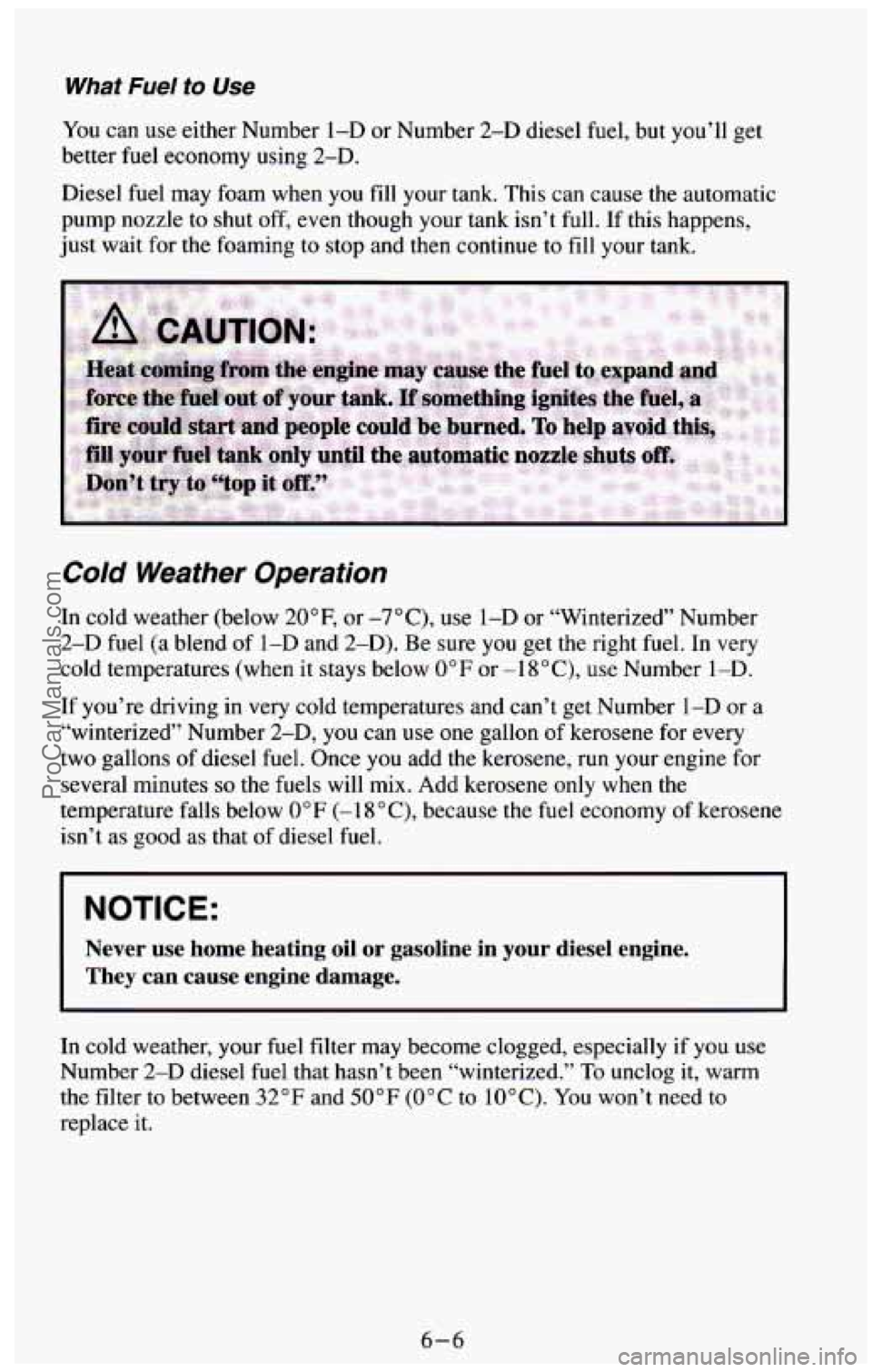
What Fuel to Use
You can use either Number 1-D or Number 2-D diesel fuel, but you’ll get
better fuel economy using
2-D.
Diesel fuel may foam when you fill your tank. This can cause the automatic
pump nozzle to shut
off, even though your tank isn’t full. If this happens,
just wait
for the foaming to stop and then continue to fill your tank.
Cold Weather Operation
In cold weather (below 20”F, or -7”C), use 1-D or “Winterized” Number
2-D fuel (a blend of 1-D and 2-D). Be sure you get the right fuel. In very
cold temperatures (when it stays below
0°F or -18”C), use Number 1-D.
If you’re driving in very cold temperatures and can’t get Number 1-D or a
“winterized” Number
2-D, you can use one gallon of kerosene for every
two gallons of diesel fuel. Once you add the kerosene, run your engine for
several minutes
so the fuels will mix. Add kerosene only when the
temperature falls below
0°F (-1 8 “C), because the fuel economy of kerosene
isn’t as good
as that of diesel fuel.
NOTICE:
Never use home heating oil or gasoline in your diesel engine.
They can cause engine damage.
In cold weather, your fuel filter may become clogged, especially if you use
Number 2-D diesel fuel that hasn’t been “winterized.” To unclog it, warm
the filter to between
32°F and 50°F (0°C to 10°C). You won’t need to
replace it.
6-6
ProCarManuals.com
Page 253 of 385
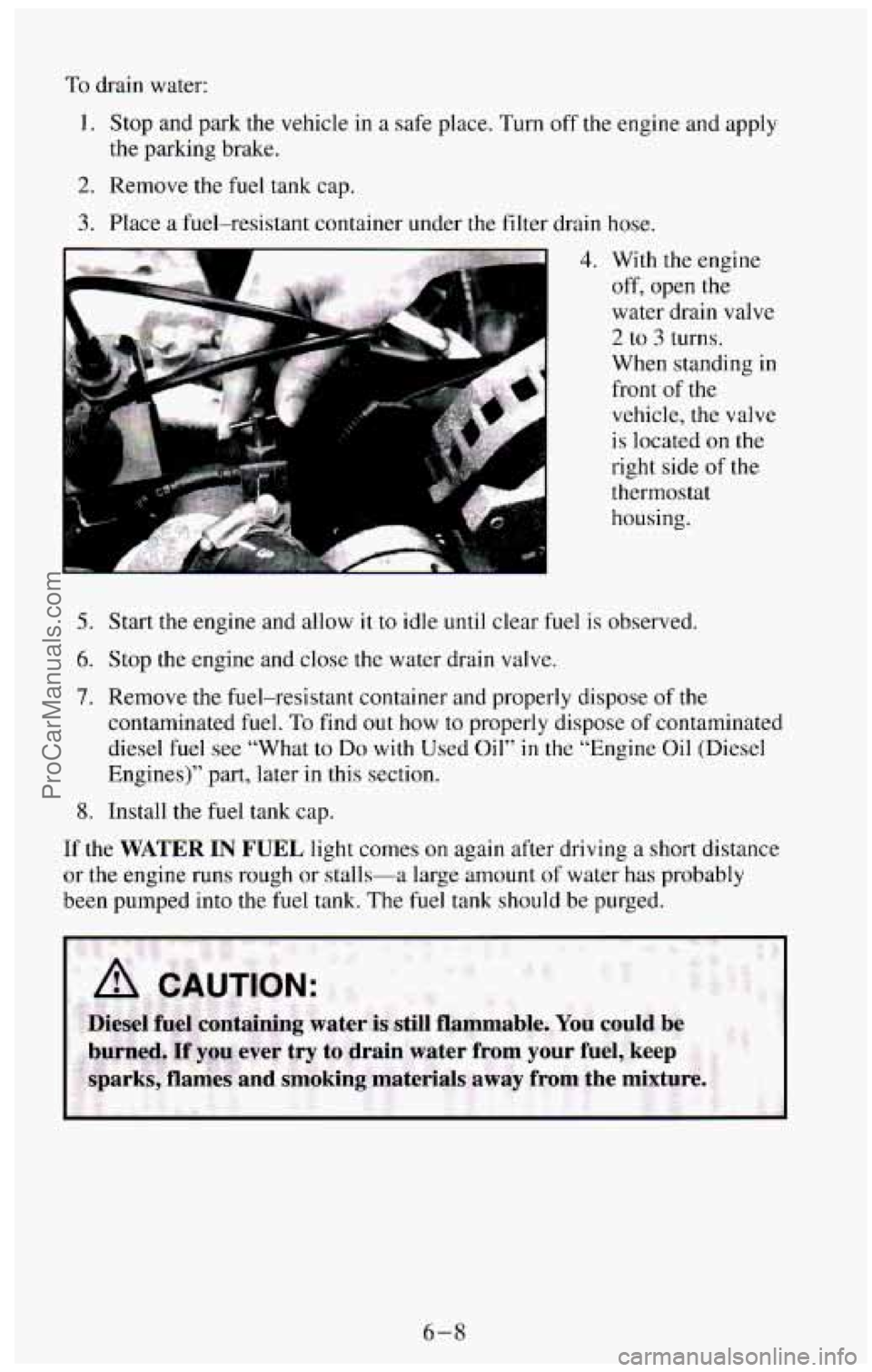
To drain water:
1. Stop and park the vehicle in a safe place. Turn off the engine and apply
2. Remove the fuel tank cap.
the parking brake.
3. Place a
fuel-resistant container under the filter
drain hose.
4. With the engine
off, open the
water drain valve
2 to 3 turns.
When standing in
front of the
vehicle,
the valve
is located
on the
right side
of the
thermostat housing.
5. Start the engine and allow it to idle until clear fuel is observed.
6. Stop the engine and close the water drain valve.
7. Remove the fuel-resistant container and properly dispose of the
contaminated fuel. To find out how
to properly dispose of contaminated
diesel
fuel see “What to Do with Used Oil” in the “Engine Oil (Diesel
Engines)” part, later in
this section.
8. Install the fuel tank cap.
If the
WATER IN FUEL light comes on again after driving a short distance
or the engine
runs rough or stalls-a large amount of water has probably
been pumped into the fuel tank. The fuel tank should be purged.
6-8
ProCarManuals.com
Page 266 of 385
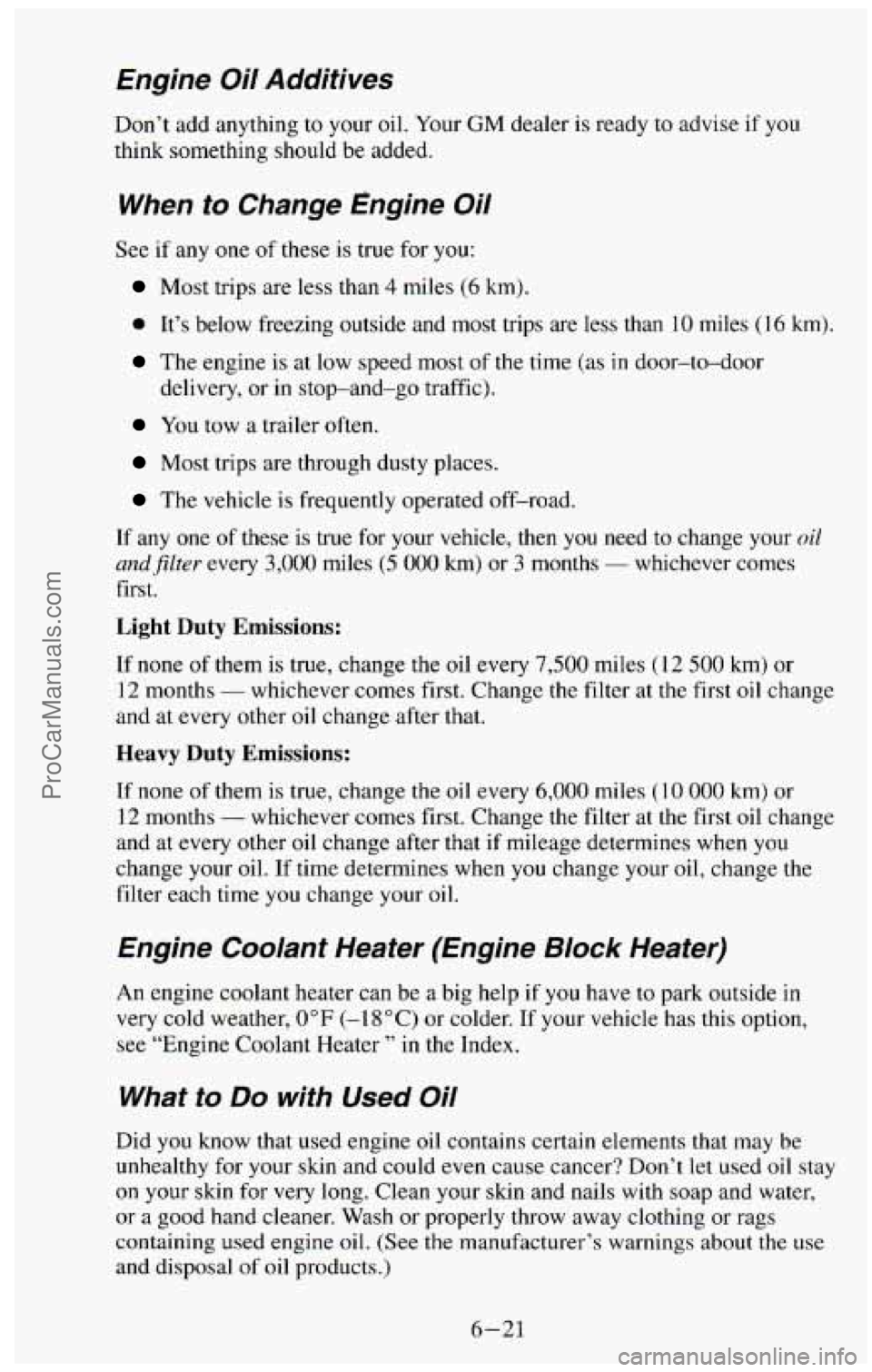
Engine Oil Additives
Don’t add anything to your oil. Your GM dealer is ready to advise if you
think something should be added.
When to Change Engine Oil
See if any one of these is true for you:
Most trips are less than 4 miles (6 km).
0 It’s below freezing outside and most trips are less than 10 miles (16 km).
The engine is at low speed most of the time (as in door-to-door
You tow a trailer often.
delivery,
or in stop-and-go traffic).
Most trips are through dusty places.
The vehicle is frequently operated off-road.
If any one
of these is true for your vehicle, then you need to change your oil
andfifilter every 3,000 miles (5 000 km) or 3 months - whichever comes
first
.
Light Duty Emissions:
If none of them is true, change the oil every 7,500 miles (12 500 km) or
12 months - whichever comes first. Change the filter at the first oil change
and at every other oil change after that.
Heavy Duty Emissions:
If none of them is true, change the oil every 6,000 miles ( 10 000 km) or
12 months - whichever comes first. Change the filter at the first oil change
and at every other oil change after that if mileage determines when you
change your oil.
If time determines when you change your oil, change the
filter each time you change your
oil.
Engine Coolant Heater (Engine Block Heater)
An engine coolant heater can be a big help if you have to park outside in
very cold weather,
0°F (-1 8 “C) or colder. If your vehicle has this option,
see “Engine Coolant Heater
” in the Index.
What to Do with Used Oil
Did you know that used engine oil contains certain elements that may be
unhealthy for your skin and could even cause cancer? Don’t let used oil stay
on your skin for very long. Clean your skin and nails with soap and water,
or
a good hand cleaner. Wash or properly throw away clothing or rags
containing
used engine oil. (See the manufacturer’s warnings about the use
and disposal of oil products.)
6-21
ProCarManuals.com
Page 267 of 385
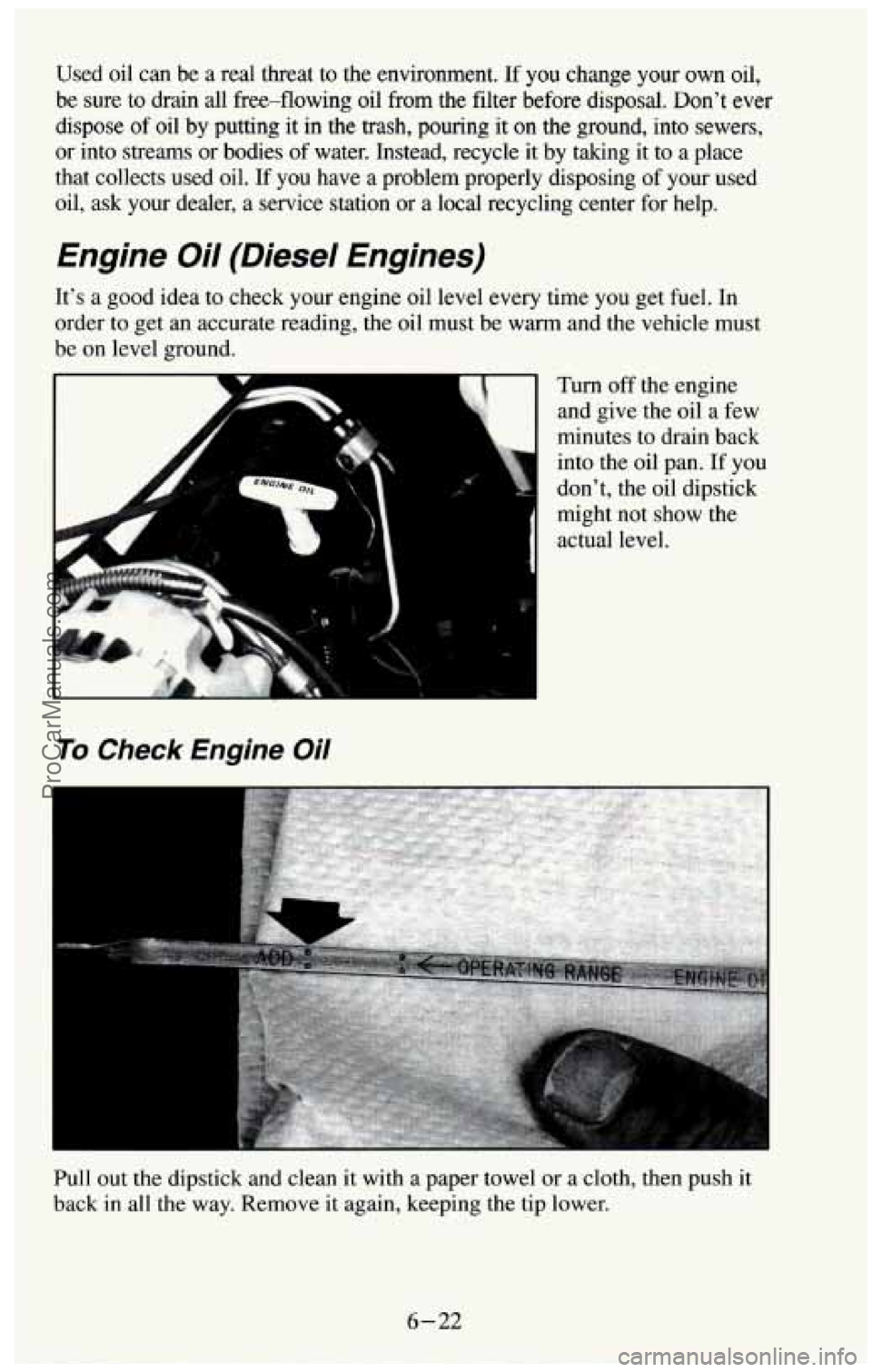
Used oil can be a real threat to the environment. If you change your own oil,
be sure to drain all free-flowing oil from the filter before disposal. Don't ever
dispose of oil by putting it in the trash, pouring it on the ground, into sewers,
or into streams or bodies of water. Instead, recycle it by taking it to a place
that collects used oil. If you have a problem properly disposing of your used
oil, ask your dealer, a service station or a local recycling center for help.
Engine Oil (Diesel Engines)
It's a good idea to check your engine oil level every time you get fuel. In
order to get an accurate reading, the oil must be warm and the vehicle must
be on level ground.
A
Turn off the engine
and give the oil a few
minutes to drain back
into the oil pan. If you
don't, the oil dipstick
might not show the
actual level.
To Check Engine Oil
Pull out the dipstick and clean it with a paper towel or a cloth, then push it
back
in all the way. Remove it again, keeping the tip lower.
6-22
ProCarManuals.com
Page 271 of 385
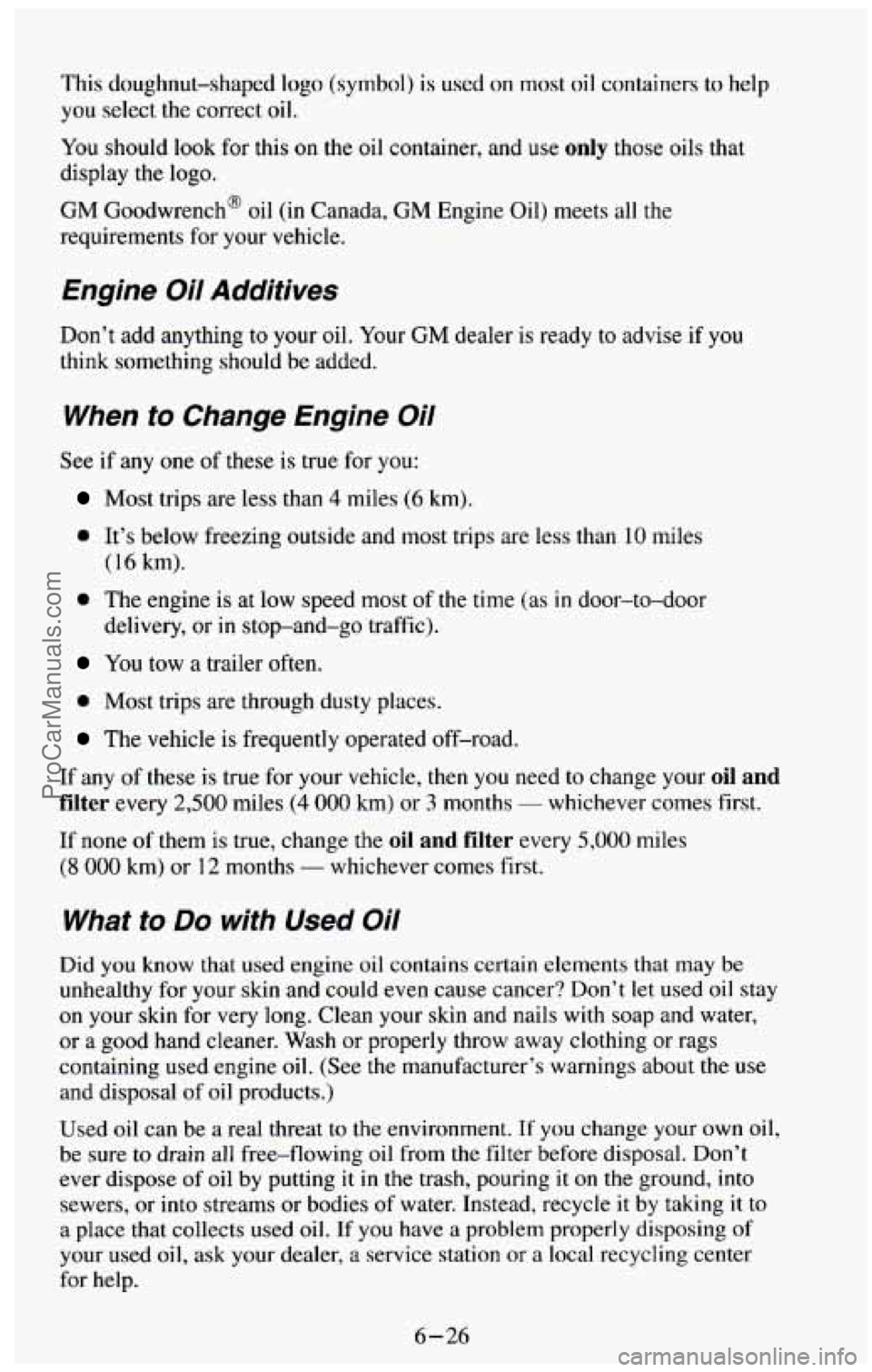
This doughnut-shaped logo (symbol) is used on most oil containers to help
you select the correct oil.
You should look for this on the oil container, and use only those oils that
display the logo.
GM Goodwrench@ oil (in Canada, GM Engine Oil) meets all the
requirements for your vehicle.
Engine Oil Additives
Don’t add anything to your oil. Your GM dealer is ready to advise if you
think something should be added.
When to Change Engine Oil
See if any one of these is true for you:
Most trips are less than 4 miles (6 km).
0 It’s below freezing outside and most trips are less than 10 miles
0 The engine is at low speed most of the time (as in door-to-door
(16 km).
delivery,
or in stop-and-go traffic).
You tow a trailer often.
0 Most trips are through dusty places.
The vehicle is frequently operated off-road.
If any
of these is true for your vehicle, then you need to change your oil and
filter
every 2,500 miles (4 000 km) or 3 months - whichever comes first.
If none of them is true, change the oil and filter every 5,000 miles
(8 000 km) or 12 months - whichever comes first.
What to Do with Used Oil
Did you know that used engine oil contains certain elements that may be
unhealthy for your skin and could even cause cancer? Don’t let used oil stay
on your
skin for very long. Clean your skin and nails with soap and water,
or
a good hand cleaner. Wash or properly throw away clothing or rags
containing used engine
oil. (See the manufacturer’s warnings about the use
and disposal
of oil products.)
Used oil can be a real threat to the environment.
If you change your own oil.
be sure to drain all free-flowing oil from the filter before disposal. Don’t
ever dispose of oil by putting
it in the trash, pouring it on the ground, into
sewers, or into streams
or bodies of water. Instead, recycle it by taking it to
a place that collects used oil. If you have a problem properly disposing of
your used oil,
ask your dealer, a service station or a local recycling center
for help.
6-26
ProCarManuals.com
Page 273 of 385
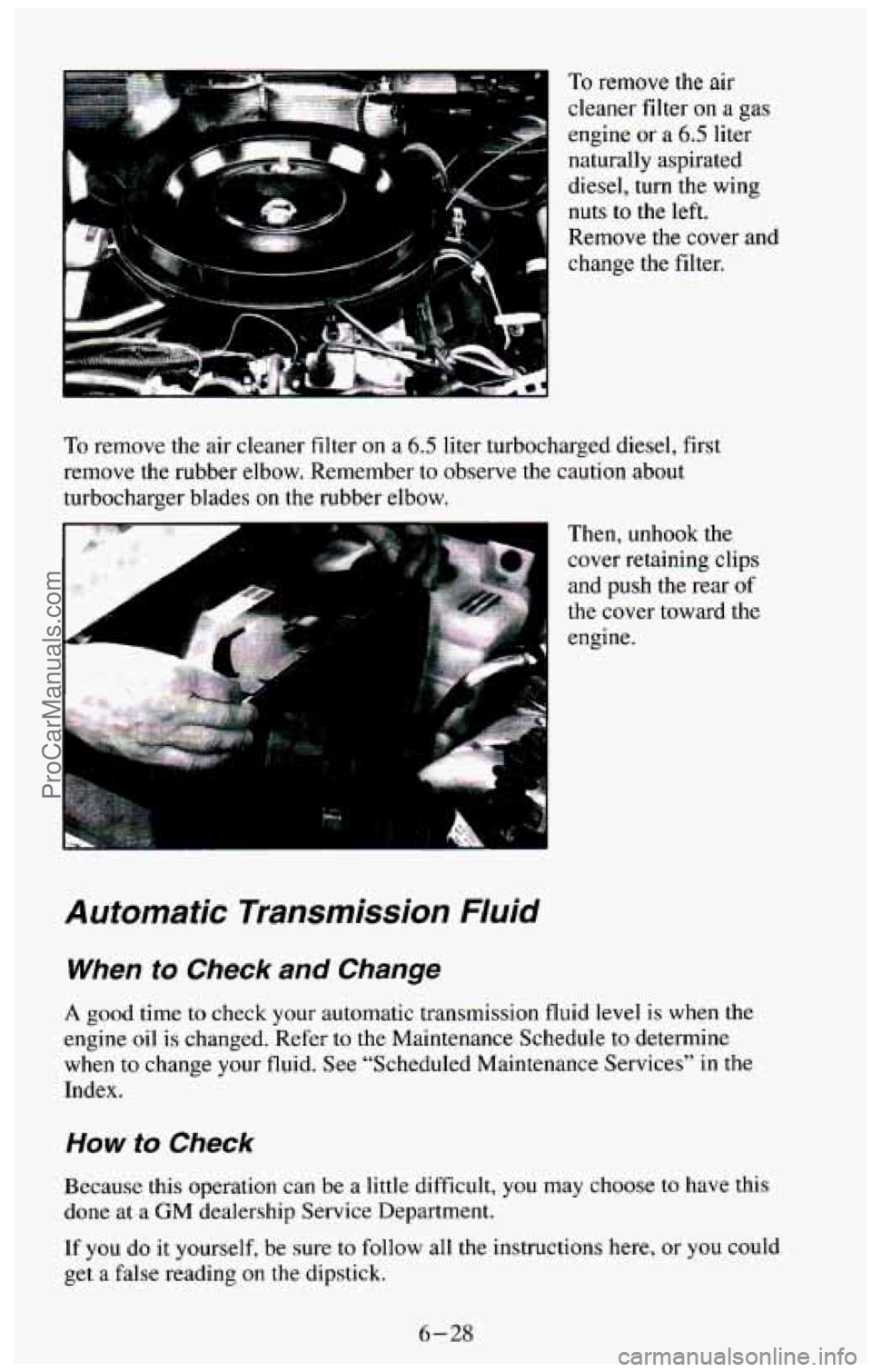
To remove the air
cleaner filter
on a gas
engine or
a 6.5 liter
naturally aspirated
diesel, turn the wing
nuts
to the left.
Remove the cover and
change the filter.
To remove the air cleaner filter on a 6.5 liter turbocharged diesel, first
remove the rubber elbow. Remember to observe the caution about
turbocharger blades on the rubber elbow,
Then, unhook the
cover retaining clips
and push the rear
of
the cover toward the
engine.
Automatic Transmission Fluid
When to Check and Change
A good time to check your automatic transmission fluid level is when the
engine
oil is changed. Refer to the Maintenance Schedule to determine
when to change your fluid.
See “Scheduled Maintenance Services” in the
Index.
How to Check
Because this operation can be a little difficult, you may choose to have this
done at a
GM dealership Service Department.
If you do it yourself, be sure to follow all the instructions here, or you could
get
a false reading on the dipstick.
6-28
ProCarManuals.com
Page 327 of 385
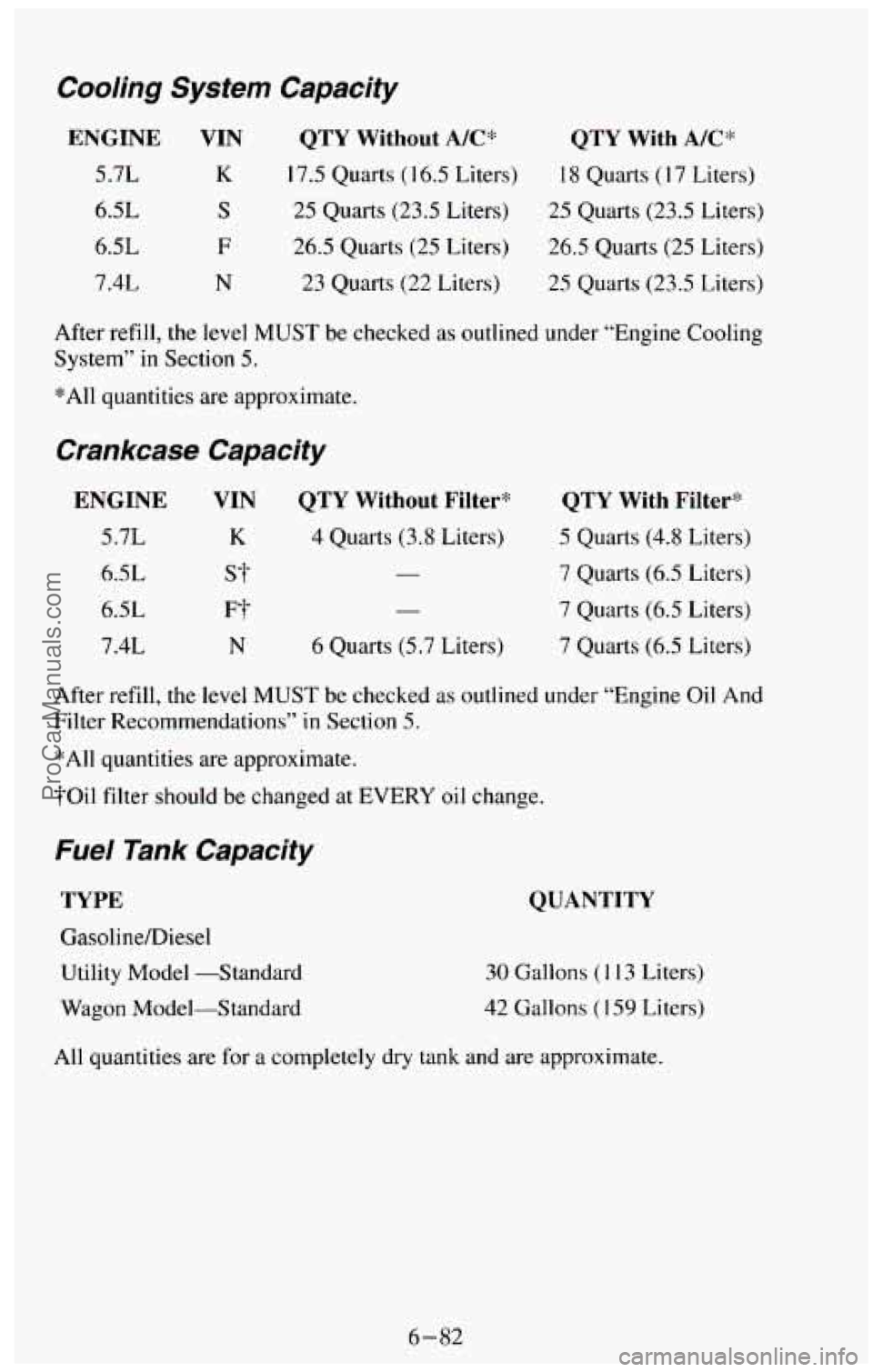
Cooling System Capacity
ENGINE VIN
5.7L K
6.5L S
6.5L F
7.4L N
QTY Without AfC* QTY With A/C*
17.5 Quarts (1 6.5 Liters)
18 Quarts ( I7 Liters)
25 Quarts
(23.5 Liters) 25 Quarts (23.5 Liters)
26.5 Quarts (25 Liters)
26.5 Quarts (25 Liters)
23 Quarts (22 Liters)
25 Quarts (23.5 Liters)
After refill, the level MUST be checked as outlined under “Engine Cooling
System”
in Section 5.
*All quantities are approximate.
Crankcase Capacity
ENGINE
5.7L
6.5L
6.5L
7.4L
VIN
K
ST
F?
N
QTY Without Filter“
4 Quarts (3.8 Liters)
6 Quarts (5.7 Liters)
QTY With Filter:$
5 Quarts (4.8 Liters)
7 Quarts (6.5 Liters)
7 Quarts
(6.5 Liters)
7 Quarts (6.5 Liters)
After refill, the level MUST be checked
as outlined under “Engine Oil And
Filter Recommendations”
in Section 5.
*All quantities are approximate.
?Oil filter should be changed at
EVERY oil change.
Fuel Tank Capacity
TYPE
Gasoline/Diesel
Utility Model -Standard
Wagon Model-S tandard
QUANTITY
30 Gallons (I 13 Liters)
42 Gallons (I 59 Liters)
All quantities are for a completely dry tank and are approximate.
6-82
ProCarManuals.com
Page 328 of 385
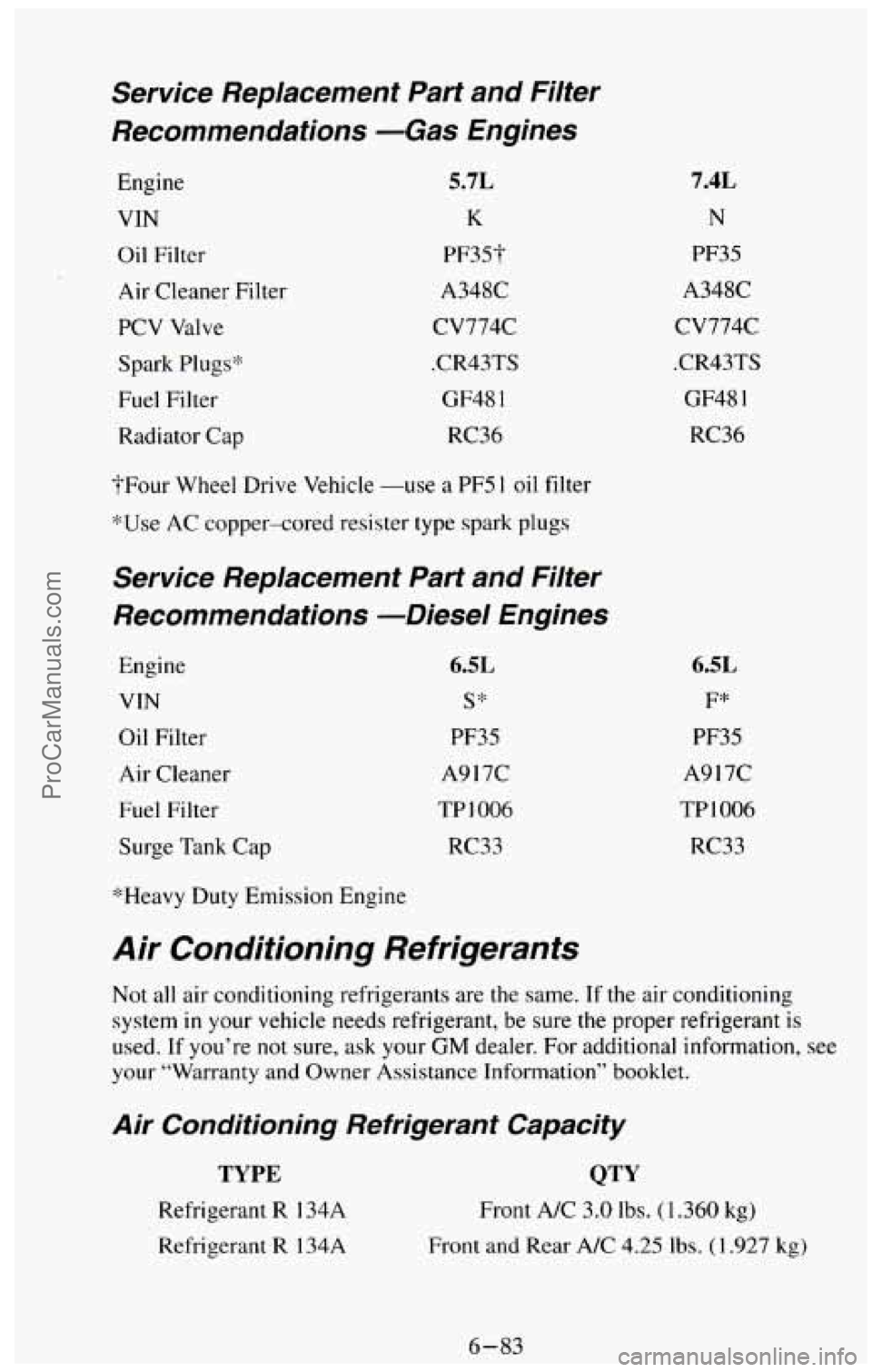
Service Replacement Part and Filter
Recommendations -Gas Engines
Engine
VIN
Oil Filter
Air Cleaner Filter
PCV Valve
Spark Plugs‘%
Fuel Filter
Radiator Cap
5.7L
K
PF353‘
A348C
cv774c
.CR43TS
GF48 1
RC36
$Four Wheel Drive Vehicle -use a
PFS 1 oil filter
*Use AC copper-cored resister type spark plugs
Service Replacement Part and Filter
Recommendations -Diesel Engines
Engine
VIN
Oil Filter
Air Cleaner
Fuel Filter
Surge Tank Cap 6.5L
S”
PF3S
A917C
TP
I 006
RC33
7.4L
N
PF35
A348C
cv774c
.CR43TS
GF48
I
RC36
6.5L
F”
PF35
A9 17C
TP
1006
RC33
*Heavy Duty Emission Engine
Air Conditioning Refrigerants
Not all air conditioning refrigerants are the same. If the air conditioning
system
in your vehicle needs refrigerant, be sure the proper refrigerant is
used. If you’re not sure, ask your GM dealer. For additional information, see
your “Warranty and Owner Assistance Information” booklet.
Air Conditioning Refrigerant Capacity
TYPE
Refrigerant R 134A
Refrigerant
R 134A
QTY
Front A/C 3.0 lbs. (1.360 kg)
Front and Rear A/C
4.25 Ibs. (I .927 kg)
6-83
ProCarManuals.com
Page 343 of 385
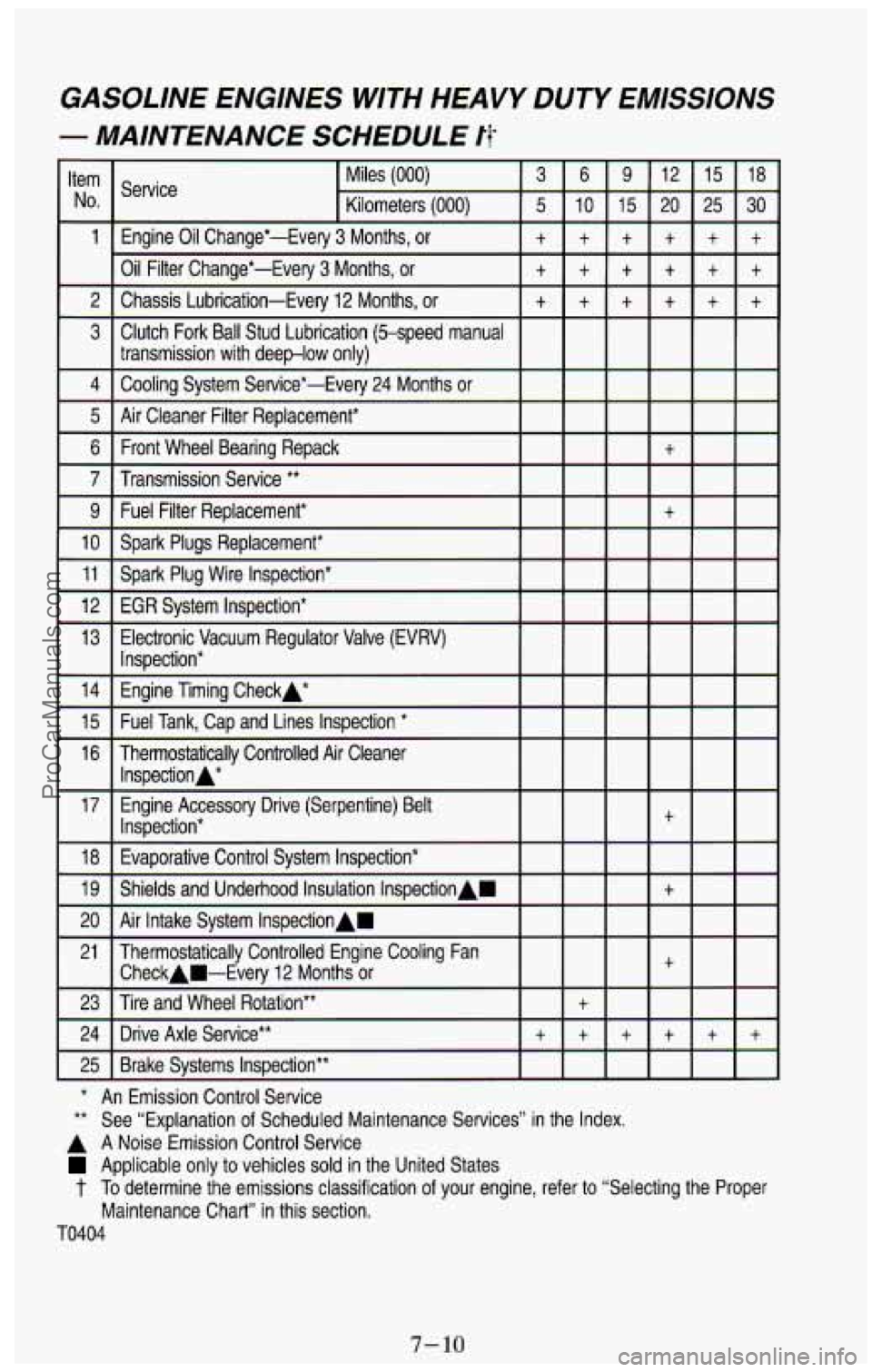
GASOLINE ENGINES WITH HEAVY DUTY EMISSIONS
- MAINTENANCE SCHEDULE yf
Item Miles (000) 3
No. Kilometers (000) 5 Service
I
1 Engine Oil Change*-Every 3 Months, or t
Oil Filter Change*-Every 3 Months, or t
12 Chassis Lubrication-Every 12 Months, or I+
II
3 Clutch Fork Ball Stud Lubrication (5-speed manual
transmission with deeplow only)
Cooling System Service*-Every 24 Months or
Air Cleaner Filter Replacement* Front Wheel Bearing Repack
Transmission Service
**
Fuel Filter Replacement*
10
11
12
13
14
15
16
17
18
I9
Spark Plugs Replacement*
Spark Plug Wire Inspection*
EGR System Inspection*
Electronic Vacuum Regulator Valve (EVRV)
Inspection*
Engine Timing Checkk
Fuel Tank, Cap and Lines Inspection
*
Thermostatically Controlled Air Cleaner
Inspectionk
Engine Accessory Drive (Serpentine) Belt
Inspection*
Evaporative Control System Inspection*
Shields and Underhood Insulation InspectionA.
20
21
-
23
24
-
Air Intake System InspectionA. I
Brake Systems Inspection** I
* An Emission Control Service
** See “Explanation of Scheduled Maintenance Services” in the Index.
A A Noise Emission Control Service
Applicable only to vehicles sold in the United States
t To determine the emissions classification of your engine, refer to “Selecting the Proper
Maintenance Chart” in this section.
TO404
7-10
ProCarManuals.com
Page 351 of 385
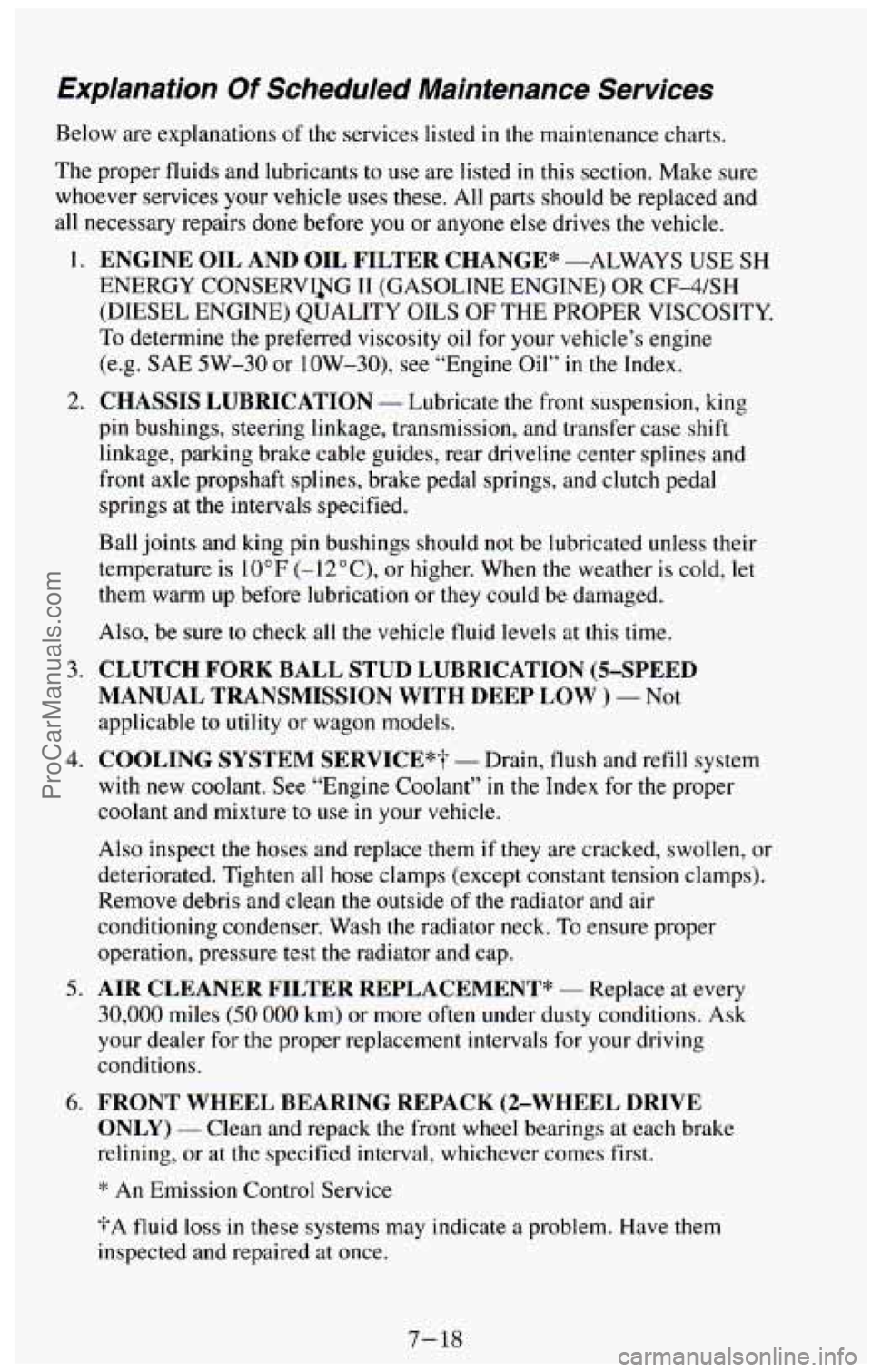
Explanation Of Scheduled Maintenance Services
Below are explanations of the services listed in the maintenance charts.
The proper fluids and lubricants to
use are listed in this section. Make sure
whoever services your vehicle uses these.
All parts should be replaced and
all necessary repairs done before you or anyone else drives the vehicle.
1. ENGINE OIL AND OIL FILTER CHANGE* -ALWAYS USE SH
ENERGY CONSERVIJTG TI (GASOLINE ENGINE) OR CF-4/SH
(DIESEL ENGINE) QUALITY OILS OF THE PROPER VISCOSITY.
To determine the preferred viscosity oil for your vehicle’s engine
(e.g.
SAE 5W-30 or low-30), see “Engine Oil” in the Index.
2. CHASSIS LUBRICATION - Lubricate the front suspension, king
pin bushings, steering linkage, transmission, and transfer case shift
linkage, parking brake cable guides, rear driveline center splines and
front axle propshaft splines, brake pedal springs, and clutch pedal
springs at the intervals specified.
Ball joints and king pin bushings should not be lubricated unless their
temperature is
10°F (-12”C), or higher. When the weather is cold, let
them warm up before lubrication or they could be damaged.
Also, be sure to check all the vehicle fluid levels at this time.
3. CLUTCH FORK BALL STUD LUBRICATION (5-SPEED
MANUAL TRANSMISSION
WITH DEEP LOW ) - Not
applicable to utility or wagon models.
4. COOLING SYSTEM SERVICE*? - Drain, flush and refill system
with new coolant. See “Engine Coolant’’
in the Index for the proper
coolant and mixture to use
in your vehicle.
Also inspect the hoses and replace them
if they are cracked, swollen, or
deteriorated. Tighten all
hose clamps (except constant tension clamps).
Remove debris and clean
the outside of the radiator and air
conditioning condenser. Wash the radiator
neck. To ensure proper
operation, pressure test the radiator and cap.
5. AIR CLEANER FILTER REPLACEMENT* - Replace at every
30,000 miles (50 000 km) or more often under dusty conditions. Ask
your dealer for the proper replacement intervals
for your driving
conditions.
6. FRONT WHEEL BEARING REPACK (2-WHEEL DRIVE
ONLY)
- Clean and repack the front wheel bearings at each brake
relining, or at the specified interval, whichever comes first.
4’ An Emission Control Service
*A fluid loss in these systems may indicate a problem. Have them
inspected and repaired at once.
7- 18
ProCarManuals.com